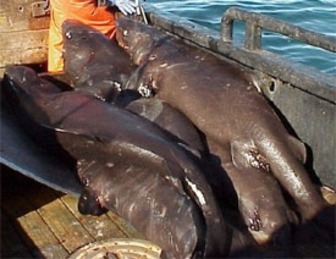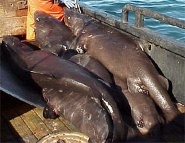Pacific sleeper shark
The Pacific sleeper shark, Somniosus pacificus, is a sleeper shark of the family Somniosidae, found circumglobally on continental shelves and slopes in temperate waters between latitudes 70°N and 47°S, from the surface to 2,000 metres .

The Pacific sleeper shark lives in the benthopelagic, marine, depth range 0 - 2000 m environment.
Pacific Sleeper Shark - the Silent Killer
 The Pacific sleeper shark (Somniosus pacificus), a quiet but deadly predator, lives in deep water, 2000m (6600 ft.), and on the continental shelves in temperate water. It lives in the North Pacific from Japan along the Siberian coast and the Bering Sea. Also, off the coast of southern California, Baja California and Mexico. In the Atlantic they are found off the coast of Uruguay. In Australasia they live from south Tasmania to eastern New Zealand. Usually just lying on the bottom of the sea, they were named sleeper sharks, but they can be very aggressive and never stop moving. This is proven by the content of the stomach of some captured specimens. They eat salmon and sea lions which are fast moving animals.
The Pacific sleeper shark (Somniosus pacificus), a quiet but deadly predator, lives in deep water, 2000m (6600 ft.), and on the continental shelves in temperate water. It lives in the North Pacific from Japan along the Siberian coast and the Bering Sea. Also, off the coast of southern California, Baja California and Mexico. In the Atlantic they are found off the coast of Uruguay. In Australasia they live from south Tasmania to eastern New Zealand. Usually just lying on the bottom of the sea, they were named sleeper sharks, but they can be very aggressive and never stop moving. This is proven by the content of the stomach of some captured specimens. They eat salmon and sea lions which are fast moving animals.
Pacific sleeper sharks are bottom feeders and prey mainly on fish, Giant Octopus and squid as well as flounders, rockfishes, pollocks, shrimps, hermit crabs and soles. Their diet depends on how big they are. Normally, the males grow to 4.4 meters (14 ft.) and females a bit less but have been seen at 7 meters (23 ft) and weigh from 700 to 800 pounds.
Pacific sleeper sharks swallow their prey whole and usually alive, if they can, and break any pieces too large to swallow with their unusual teeth. The upper teeth are like spikes and the lower teeth are oblique cusps. A 12 ft. female was found with an intact Southern Rightwhale dolphin in her stomach. When food is hard to find they are also scavengers and feed on carrion.
For reproduction, the eggs are retained within the body (ovoviviparous) in a brood chamber in the female until the embryos develop. The embryos are nourished from a yolk sac inside the egg and when they break out of the egg, still inside the mother, they are born soon afterwards. Called pups, there is sometimes 300 in one litter.
Pacific sleeper sharks will not prey on humans and humans cannot eat pacific sleeper sharks without months of preparing the meat. They have a toxin in their flesh that causes the symptoms of drunken behavior in humans. Their liver is also different from other sharks. Because they are deep water fish, the squalene in shark’s liver oil would solidify in the cold depths and make them too heavy to rise. They have compounds in their liver that are low-density and maintain liquidity at very low temperatures. Staying in the dark depths during the day, they come closer to the surface at night.
The IUCN Red List Status DD (data deficient). Other than man, who kills them for poaching on their fishing lines, only other sharks can successfully attack them.
Common names
Greenland shark in English
Greenland sleeper shark in Unknown
K'wet'thenéchte in Salish
Laimargue dormeur in French (français)
Ondenzame in Japanese (日本語)
Pacific sleeper shark in English
Pacifische ijshaai in Dutch (Nederlands)
Requin dormeur du Pacifique in French (français)
sleeper shark in English
Southern sleeper shark in English
Stillehavshavkal in Danish (dansk)
Tiburón dormilón del Pacifico in Spanish (español)
Tollo dormilón in Spanish (español)
Tollo negro dormilón in Spanish (español)
Whitely's sleeper shark in English
Акула полярная тихоокеанская in Russian (русский язык)
акула тихоокеанская полярная in Russian (русский язык)
太平洋睡鯊 in Mandarin Chinese
太平洋睡鲨 in Mandarin Chinese


Original source: FishBase
Permission: Some rights reserved
Family : Somniosidae
Genus : Somniosus
Species : Somniosus pacificus
Authority : Bigelow and Schroeder, 1944
